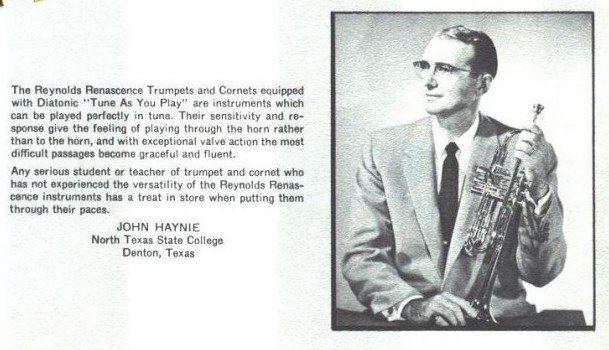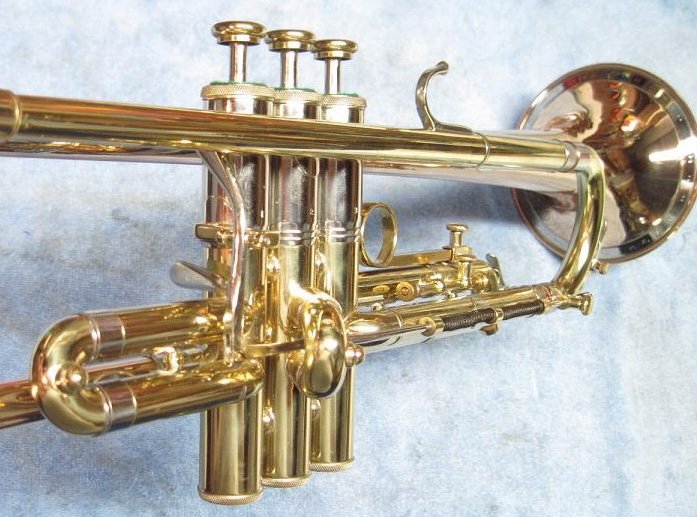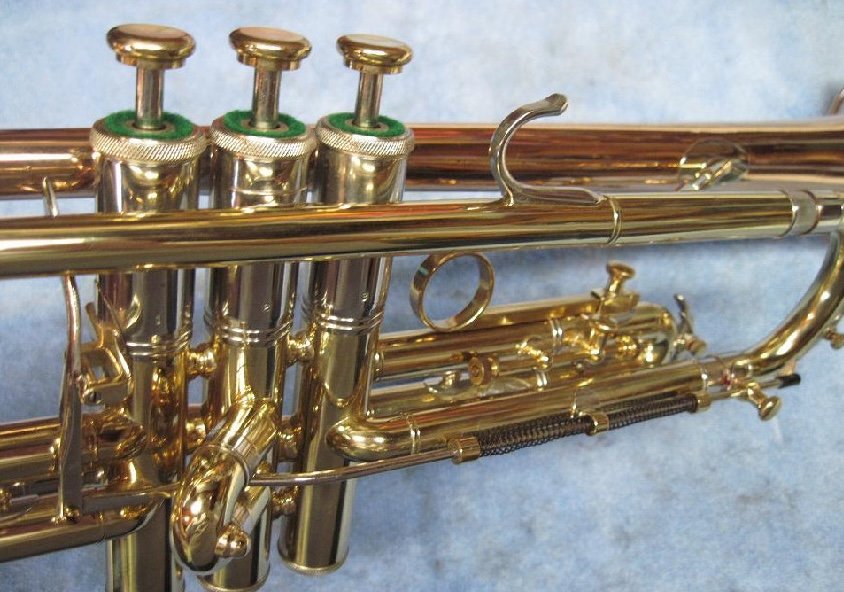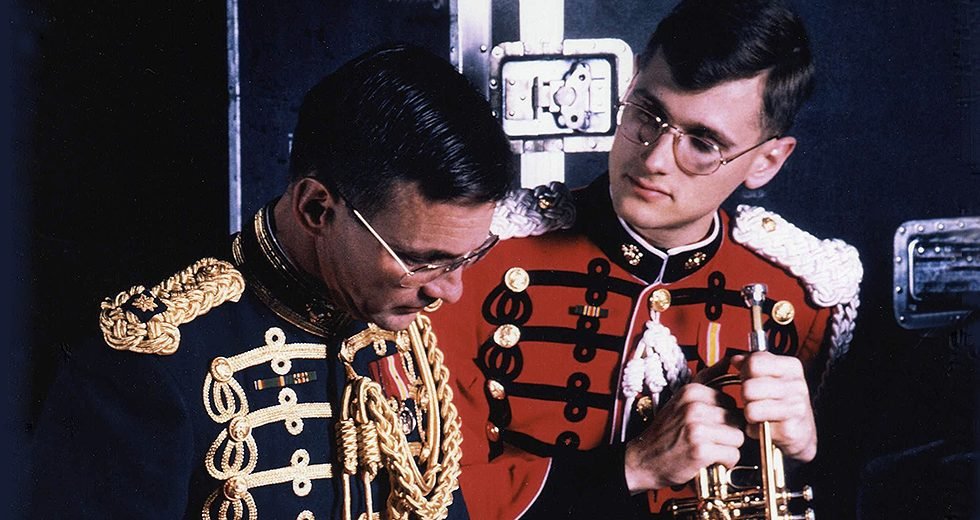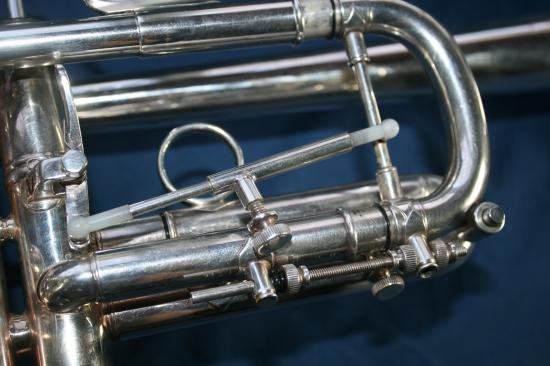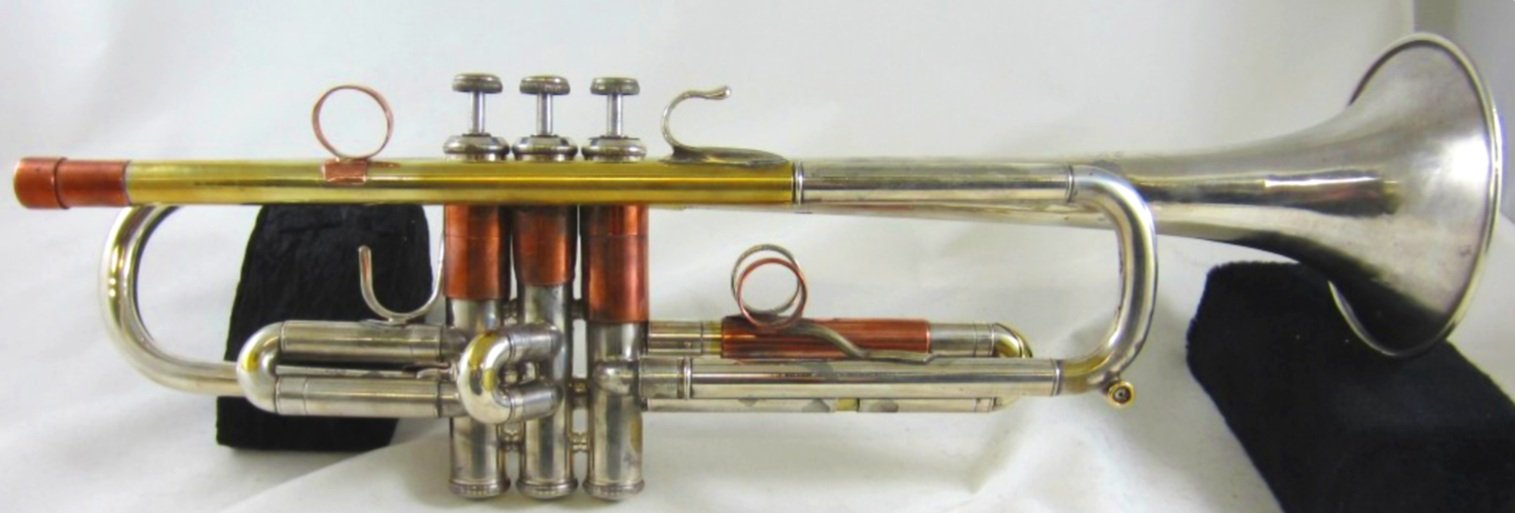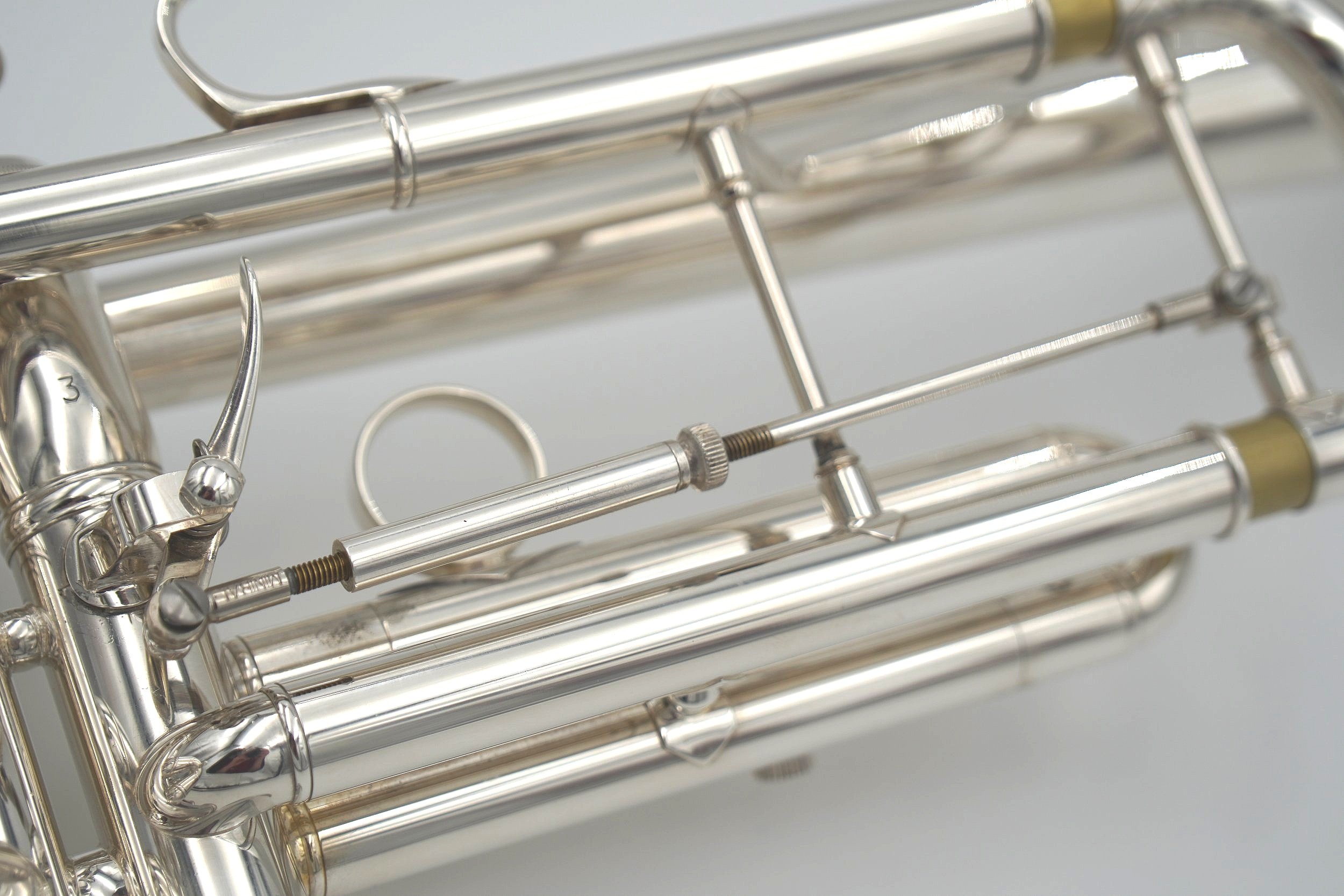
What is a Pitchfinder/Main Tuning Slide Trigger?
Pitchfinders, also known as “main tuning slide triggers” are triggers that allow you to adjust the position of the main tuning slide of the trumpet while you’re playing. Most of the modern designs only push the main tuning slide out, flattening the pitch, but historically there have been versions that could both push the main tuning slide in AND out - but since most out of tune notes are sharp, the more modern trigger designs allow the player to correct most notes with the easy push of a trigger instead of lipping notes down with their embouchure.
Pitchfinder close up - Yamaha Chicago II Bb tuning slide
Pitchfinder installed on my custom A slide made for my Yamaha Chicago II Bb trumpet
Pitchfinder on my Yamaha Chicago II Bb trumpet
Pitchfinder on my Yamaha Chicago II C Trumpet
Why Get a Main Tuning Slide Trigger?
The short answer is, the trumpet without any modifications does not play in tune with itself. If you’re playing a note that requires the first or third valve, you can always adjust the intonation using the saddles on the first or third slides - but If you are playing a note that is open or fingered just with the second valve, there’s no way (without a pitchfinder) to change the intonation on the fly without muscling the note using your chops.
On most trumpets, low C is a little sharp, middle G flat, middle C sharp, fourth space e flat, top of the staff G is really sharp, and high C is squirrelly!
Even if you had a trumpet that played perfectly in equal temperament, the ideal intonation will change depending on the chord function. Again, while you could always use your chops to correct intonation, the color and timbre will naturally change when you’re playing in a different part of the slot, and it’s more tiring to adjust pitch this way.
This is where the pitchfinder/main tuning slide trigger comes in - these mechanisms change the total length of the trumpet and allow more ability to adjust intonation and to control color/timbre.
Condensed History of Main Tuning Slide Trigger Designs
Conn Wonder Cornet
Conn introduced the Wonder model cornet in 1886, shortly after purchasing the Isaac Fiske factory in Worcester, Massachusetts (brasshistory.net). Though it was introduced 136 years ago (as of 2023) - the Conn Wonder Cornet was ahead of it’s time and DID feature a way to “pitchfind” - using a pair of push rods on top of the main tuning slide that allowed you raise the pitch with your left thumb, and lower it with your 2nd or 3rd finder on the bell side of the valve casing. It’s not a technically a “trigger” but certainly these mechanisms qualify as pitchfinders, at least in my opinion! Thanks to Ron Berndt of trumpet-history.com for bringing this example to my attention.
Conn Wonder Cornet (Photo Credit: Robb Stewart)
Check out 1:29 - Trent Austin shows how the pitchfinder on the Conn Wonder worked!
Mark Hindsley’s “Tune-As-You-Play” Mechanism
An interesting earlier example of a main tuning slide trigger is referenced in Dave Hickman’s pedagogy book (pg 289). Mark Hindsley, the band director at University of Illinois from 1948-1970, designed and patented a mechanism for both the cornet and the trumpet to allow you to change the position of the tuning slide while playing, fittingly called the “Tune-As-You-Play” (TAYP for short).
In 1950, Hindsley’s son in law, John Haynie (longtime professor of trumpet at University of North Texas) convinced the Reynolds company to commercialize the device on their Renascence model trumpets and cornets, which you can see below in advertisements from back in those days.
There appear to be two versions of the TAYP mechanism -
A trigger with two thumb paddles, one above and below the trigger’s fulcrum. Pressing the higher thumb paddle causes the tuning slide to retract, sharpening the pitch, and pressing the lower thumb paddle causes the tuning slide to extend, flattening the pitch. This is the version seen in the advertisements as well as the pictures of the Contempora Bb from contemporacorner.com
A trigger with an adjustable thumb ring. In this arrangement. Pushing the thumb in towards the valve block retracts the tuning slide (to sharpen) and pulling the thumb away from the valve block extends the tuning slide (to flatten). This is the version seen in the linked Samuel Plays Brass video as well as the photos of the Contempora C trumpet (which belonged to NTSC, the school Haynie taught at!) in the gallery below (thanks to Subtropical and Subpar on TrumpetHerald for providing those!).
A TAYP mechanism moving the tuning slide in and out. (Video credit: Subtropical and Subpar, TrumpetHerald)
How the native tuning slide position is adjusted on the TAYP (and how it allows you to remove the tuning slide). (Video credit: Subtropical and Subpar, TrumpetHerald)
Mark Hindsley, creator of "Tune-as-you-play" pitchfinder
John Haynie, Professor of Trumpet at North Texas State College (later University of North Texas)
Reynolds Advertisement showing Renascence TAYP on a cornet
Reynolds Advertisement showing Renascence TAYP on a trumpet
Reynolds Contempora Renascence Bb with TAYP trigger - notice the two thumb paddles on either side of the fulcrum. (contemporacorner.com)
Side view of TAYP (contemporacorner.com)
Bell view of TAYP (contemporacorner.com)
Reynolds Contempora Renascence C with TAYP - basically the same mechanism but with a single thumb ring instead of two separate paddles. (PC: Subtropical)
Close up view of the TAYP. (PC: Subtropical)
North Texas State College (later University of North Texas) marking on the case of the pictured Contempora C trumpet.
The Jack Holland Pitch Finders
Later, Jack Holland, who was the Principal Trumpet of the Houston Symphony from 1955-1957, developed a tuning slide trigger design that is officially called the Pitch Finder. This device (like both the Conn Wonder and TAYP systems mentioned above) allowed both sharpening and flattening the pitch, but Jack Holland’s version featured many modular parts. There were several different iterations of this, but generally they featured a first valve trigger that allowed you to pull in the tuning slide, as well as a third valve slide-mounted swivel ring that you could use to move the main tuning slide in or out, as well as the third valve slide alone depending on the configuration. As you can imagine, the mechanism was rather heavy and cumbersome. It had many solder points onto the trumpet, leading to a dampening effect on the sound.
Technically, “Pitch Finder” is actually a trademarked term referring to this specific device. Nowadays, we tend to call all main tuning slide triggers “Pitchfinders,” despite how different modern examples are from Jack Holland’s design. Shout out to Dr. Dan Shipman, full-time professional freelance trumpet player and musician contractor from Houston, TX for his in-depth insight into this design, and to *someone I need to find the name of in my messages* for the clips and pictures of the Pitch Finder III mechanism and instruction manual.
Jack Holland Pitch Finder III in action!
Jack Holland III Pitchfinder
Jack Holland Pitchfinder deconstructed parts
Jack Holland Pitch Finder with the left thumb trigger component on a short bell Eb trumpet (PC: Horn Stash)
Jack Holland Pitchfinder Diagram
The Modern Era - the Hagstrom/Kratz/Tanabe Versions
John Hagstrom had what I believe is the earliest version of the most commonly seen “modern” tuning slide trigger done in 1992 when he was in the President’s Own Marine Band. Hagstrom noticed that the G on top of the staff was extremely sharp on his horn at the time, so with the help of master repairman and horn player for the US Army Band, Dave Kratz, he refashioned a first valve trigger to extend the other direction, and attached it to the main tuning slide. The connection rod (or “con-rod”) was telescoping, so you could set different native tuning slide positions. There was also a stop rod system in this earliest version, allowing you to pick the in and out stopping points of the main tuning slide. Of course, to make this trigger work well, the main tuning slide also had to be lapped to allow for easier and smoother movement.
Hagstrom used this main tuning slide trigger design for both of his auditions for the Chicago Symphony - the 4th Trumpet audition in 1996 and the 2nd Trumpet audition in 1998.
After the first version that Hagstrom and Kratz had created, Hagstrom worked with Wayne Tanabe at his shop “The Brass Bow” to adapt and duplicate that design for many of the other trumpets and cornets that Hagstrom owned. Eventually, Hagstrom shared that design with Charlie Geyer in 1997 - and as a result, Charlie Geyer is now recognized as a major proponent of the main tuning slide trigger and recommends them to a large percentage of his students (myself included). He once told me that he believes that playing with legitimately good intonation is a big part of what makes any trumpet playing beautiful.
After these Hagstrom versions, Charlie Melk and Bob Osmun created their own versions of this design.
Thanks so much to John Hagstrom for generously sharing all of this information with me.
Example of Hagstrom-style main tuning slide trigger with stop rod to define in/out position (photo credit: David Hunsicker, trumpetgapper.com)
Hagstrom/Tanabe design, AKA "Charlie Geyer Memorial Trumpet" (The Instrumentalist, Nov 2001)
John Hagstrom as a member of the President's Own Marine Band
David Kratz worked to create early versions of the main tuning slide trigger design popularized by John Hagstrom
Charlie Melk turnbuckle "Pitchfinder" (detached)
Charlie Melk "Pitchfinder" (turnbuckle style)
Charlie Melk "Pitchfinder" (screw rod style)
Osmun "Pitchfinder" (only offered in screw rod style)
Use Cases for the Main Tuning Slide Trigger
It’s a common misconception that pitchfinders are found on instruments that play particularly out of tune. Sometimes this is the case, but often it’s been installed to give the player more intonation and color flexibility. Personally, I have them on two instruments - my Yamaha Chicago Bb and C trumpets. Both of these instruments already played as evenly and as in tune as could be expected on any professional trumpet - BUT I installed main tuning slide triggers on these horns to give me more options for intonation, and especially to control top line G. In my job as Second Trumpet in the Charlotte Symphony, I have found it indispensable to be able to adjust pitch on the fly for the reasons below -
Use cases
Control the pitch of 6th partial HIGH G and F#, or any sharp notes that are open or 2nd valve only. G and F# are especially notable because their lower octave brethren are flat notes, which makes these especially sharp sounding in comparison. Low C can also be frustratingly sharp even on very good modern piston C trumpets
Playing the third of a chord - no matter what note you’re playing, a third of the chord needs to be 14 cents lower than “in tune” in equal temperament.
Adjusting for being sharp in the upper register, particularly when your chops are tired
Adjusting for being sharp due to a mute (especially very tight mutes, like I’ve found with my Trumcor Lyric straight mute)
Matching pitch with “differently tuned” tune ensemble members - maybe you share a note with someone who is playing in a different part of the pitch due to the idiosyncrasies of their instrument and range (either different keyed trumpets/low brass, woodwinds, or organ)
Color adjustments - You can brighten the sound by setting the slide “sharp” and lipping down to the lower part of the slot. You can also push the trigger out and lip up, which will slightly dull the sound. Thanks to Dr. Dan Shipman for sharing this clever use case on Trumpet Herald!
You might be wondering if you can use the main tuning slide trigger in place of adjusting your first or third valve slides - and I guess you could, but personally I prefer to use them mostly for open or 2nd valve notes because actuating the trigger is a bit more physically disruptive than just moving 1st and 3rd slides with a ring or saddle. As Professor David Hickman says - “the shift in length causes the tuning slide to vary in proportion to the overall conical-cylindrical ratio of the leadpipe and tuning slide together, causing a wider range in the feel of blowing resistance and slotting of each note.”
One misconception about main tuning slide triggers is that using them somehow makes you “always in tune.” That would be nice, but honestly that’s ridiculous! The true “pitchfinders” are the ears on either side of your head combined with the brain that receives and interprets their signals. Something really important to understand is that chops are STRONGER than slides and can always push a well-intentioned tubing length out of tune and out of color. The trigger is just another tool in the toolbox.
Potential Drawbacks
As with any trumpet modification, there are some potential drawbacks of playing an instrument with a main tuning slide trigger.
Some considerations:
Leaks - The tuning slide legs must be lapped down to move in and out as smoothly as desired, leading to the potential for air leaks if it is not greased regularly to give it the proper seal.
Getting Stuck - If not maintained properly, the mechanism can get stuck. To prevent this, I like to use a lighter tuning slide grease, like Zaja Red or Hetman Tuning Slide #5 on my main tuning slide legs, instead of the typical “slow” slide grease.
Dampening Effect - Due to the added weight and tension of the trigger mechanism, main tuning slide triggers can have a slight dampening effect on the sound. Unfortunately, there’s nothing really to be done about this. Modern designs have improved upon Jack Holland’s original Pitch Finder design to minimize this by reducing the overall weight and number of hard connections to the trumpet.
Over-Adjusting - Since it’s so easy to adjust the pitch on the fly, you may find yourself unnecessarily adjusting your main tuning slide trigger, causing more problems with intonation instead of solving them.
Broken Springs - Once every few years, the spring will break just like a tuning slide water key spring, leaving the tuning slide far too easy to accidentally adjust with the trigger.
Grip Change - On a piston trumpet with a main tuning slide trigger, I noticed I had to slightly adjust my standard grip to allow me to actuate the trigger without repositioning my hand as I play. (BEFORE AND AFTER photos)
Dependence - If you have a number of trumpets you normally perform on like I do, you might get really frustrated with horns in you collection that DON’T have a main tuning slide trigger, since you’re so used to having that level of control.
Common Designs
Hagstrom/Kratz/Tanabe Design
The most common design you’ll see nowadays on piston trumpets features a trigger that only pushes the main tuning slide out, flattening the pitch. These designs, including those by Charlie Melk and Bob Osmun featured below, are inspired by that original version created by John Hagstrom and Dave Kratz. It works well on piston Bb and C trumpets as well as short bell model D and E-flat trumpets. This is by far the most common main tuning slide trigger design you’ll see in the wild.
Charlie Melk Version
Charlie Melk’s version of the pitchfinder, which I have on my Bb and C trumpet, comes in two slightly different configurations. The length of the con-rod can be adjusted with either a turnbuckle OR a screw rod system. I prefer the turnbuckle since it allows for very small adjustments to the tuning slides native position without even looking at it, but many people prefer the stop screw version since it is faster to adjust the native tuning position as well as faster to completely remove the tuning slide.
Melk - Turnbuckle style
Melk - Screw rod style
Osmun Version
The Osmun version is very similar to Charlie Melk’s. It features the screw rod system and option for return stop screw, which can prevent the trigger from returning all the way if you want to reduce the throw of the trigger. It also includes some plastic components which reduces the overall weight, potentially helping reduce any attenuation from the added weight of the trigger. Thanks to CA freelancer and friend John Freeman for the close-ups of this design!
Osmun “Pitchfinder”
(photo credit: John Freeman)
Osmun - close up of return stop screw
Cornet Designs
A fair number of manufacturers actually sell cornets with a main tuning slide trigger as a stock option! Cornet main tuning slide triggers are typically exactly where cornet first valve triggers are normally located, and the trigger mechanism either routes around or through the gap in the first valve slide.
Multi-talented friend and content creator David Koch over at Cookie’s Music even made one for himself on his Van Laar cornet (not recommended unless you have lots of instrument modification practice like him). Again, this is a great example of how even when you have instruments that already play very well in tune, artists sometimes choose to give themselves more options through customization.
Besson cornet with pitchfinder
Van Laar cornet with pitchfinder by David Koch
(Video credit: David Koch)
Tunable Bell Trumpets
Many Eb/D or G/F trumpets come in a tunable bell configuration, which does not feature a main tuning slide. Even so, there are still several approaches to achieving “on-the-fly” pitch adjustment that work well for this design.
(Simplest Option) Loosen both the screws holding the bell in place on both the rail along the valves as well as the bell tail. Then, you can move the bell in and out while you play with your forefinger. To make this more ergonomic, Prof. Geyer had a first valve saddle installed on his bell (video below). The upside of this method is that it lets you bring the pitch up OR down on any note. However, the downsides are that the bell will vibrate more due to the reduced number of firm connections to the valve block, and you have to remember the “native” tuning bell position by feel.
Install a trigger specifically to move the bell. You can either use a screw rod system mounted along the bottom of the bell, or you could have a peg mounted to the bell crook. The upside to this version is that the trigger will always return to the native position when released, and the downside is that the bell screws still have to be loose, which reduces the firmness of the connection between the valve block and bell.
Dan Shipman even had a bell trigger installed on his Spencer Bb/A tunable bell piccolo trumpet, which is similar to the designs of the Yamaha 9910 and Schilke C5-4 piccolo trumpets. Since piccolo trumpets are so short, the throw doesn’t have to go very far!
Tunable bell with saddle installed on Schilke E3L Eb/D trumpet
Tunable bell with saddle installed on Yamaha 9710 G/F trumpet
Tunable bell trigger on 4v B&S Eb trumpet made for Dr. Dan Shipman
Tunable bell trigger on a Bb/A Herald Style Piccolo by Will Spencer for Dr. Dan Shipman
Tunable bell trigger on a C/Bb Herald Style Schilke Piccolo Trumpet (PC: Ben Hauser)
Flugelhorn Designs
Flugelhorns are tricky because most common designs don’t have a tuning slide, but instead have a tunable leadpipe. I haven’t seen an effective “pitchfinder” design for this arrangement (I wouldn’t want an entire instrument slamming towards my face when releasing the trigger!). That said, if the flugelhorn has a tuning slide, it can obviously still have a main tuning slide trigger. All three examples shared below are from fellow pitchfinder fanatic Dr. Dan Shipman -
4 valve B.A.C. (Best American Craftsmen) custom flugelhorn - not only does it feature a very unique 4th rotor valve, but it also has a very ergonomic tuning slide trigger (down only) where the 3rd valve trigger would normally be. Another example is this beautiful flugelhorn made by Anton Possegger which also features an up and down main tuning slide trigger, operated by the left thumb.
3 valve Adams F2 flugelhorn, custom made by Miel Adams to have a main tuning slide with a down-only trigger.
4 valve Possegger MataFlugelhorn with an up and down pitchfinder by Anton Possegger.
BAC 4v custom flugelhorn with pitchfinder made for Dr. Dan Shipman
Adams F2 Flugelhorn with pitchfinder made for Dr. Dan Shipman by Miel Adams
Possegger MataFlugelhorn with pitchfinder made for Dr. Dan Shipman by Anton Possegger
Rotary Trumpet Designs
Thein has a fabulous tuning slide trigger mechanism that is spring loaded and can push the tuning slide in or out. This design features a ring around where the third valve slide trigger is normally located on the front edge of the first valve slide. You then can use your thumb to push the ring either direction, and when you let go the spring loaded mechanism always returns the tuning slide to its native position. This allows for the extra use case of bringing up the pitch when the instrument is cold as well as bringing up the rotary trumpets flat notes, such as the low C. Thanks to Matthias Hofs especially for working with thein to create so many models with the option of a main tuning slide trigger. I’ve even seen these Thein “pitchfinders” installed on other, more “intonation challenged” rotary trumpets.
Thein 4v rotary trumpet with Thein pitchfinder
Thein pitchfinder (notice the second saddle above the thumb ring that seperately operates the 3rd slide?)
Monke C Rotary with a Thein pitchfinder (Video credit: Benny Nguyen)
Monke D Rotary with a pitchfinder by Joe Loeffler (Video credit: Joe Loeffler)
Kanstul Bugles - the “Tune-Any-Note” slide
For the DCI fans out there I bring you the Kanstul Bugle line, where EVERY SINGLE MODEL (down to the marching contrabasses!) features their “Tune-Any-Note” slide, which is a left thumb saddled slide that’s spring loaded to allow you to sharpen or flatten any pitch.
Kanstul 3 valve Soprano G Bugle with “Tune-Any-Note” slide (lower left), spring loaded to allow sharpening and flattening of any pitch.
(photo credit: Patrick Surace, ArtStation)
Kanstul 3 valve Soprano G Bugle with “Tune-Any-Note” slide (lower right) with saddle visible
(photo credit: Patrick Surace, ArtStation)
Other Examples
Over the years (and since my video about Pitchfinders has come out), I have come across several unique examples of main tuning slide triggers and saved them on my phone. Below are some examples of how they can be done differently.
Pitchfinder by Ackright (screw rod style) with stop rod to define in/out position
TAYP-style pitchfinder on a Benge 1XMLP C Trumpet (unknown tech)
A pitchfinder that is simply a rod/ring attached directly to the tuning slide, with no triggers. (tech unknown)
Pitchfinder by unknown - interesting to see it mounted on the bottom of the tuning slide! (TrumpetHerald)
A pitchfinder by Lechner installed on a Bach C Trumpet (TrumpetHerald)
An "upside-down" pitchfinder by Dennis Houghton using parts from a Melk pitchfinder made for Stuart Stephenson (Principal Trumpet, Dallas Symphony)
Pitchfinder via a "tuning bell" crook on a Selmer Paris ERA II 92CD C Trumpet
PUJE by Brent Peters - All Puje models feature a pitchfinder in place of a first valve slide ring by adding an extra slide at the beginning of the bell tail. (pujetrumpet.com)
The Puje Pique - a Bb/A Piccolo with a pitchfinder!
The Holton Jumbo/MF FIrebird features a trombone style slide that has 4 positions in addition to the 3 piston valves. Though not technically used as a pitchfinder, it still kind of is one. (Robb Stewart)
How to Get a Main Tuning Slide Trigger
If you’re interested in getting a main tuning slide, I recommend getting in touch with either Charlie Melk of Charlie Melk’s Brass Works, or Osmun Music to discuss your options. Contact information for these shops and other brands with main tuning slide designs are listed below.
Charlie Melk’s Brass Works (Charlie Melk)
http://charliesbrassworks.com/
Charlie's Brass Works
1545 N. ExpressWay, Suite 302
Griffin, GA 30223
470-488-1153
——
Osmun Music
https://osmun.com/repair-services/
Osmun Music Inc
77 Powdermill Rd.
Acton, MA 01720
info@osmun.com
978 823-0580
Sources/Special Thanks:
Dr. Dan Shipman for the pics of his MANY custom trumpet triggers!
David Koch for video of his custom cornet trigger
John Freeman for Osmun version
Benny Nguyen for Thein version
Joe Loeffler for his custom version on D Monke
John Hagstrom for info regarding history of his design






